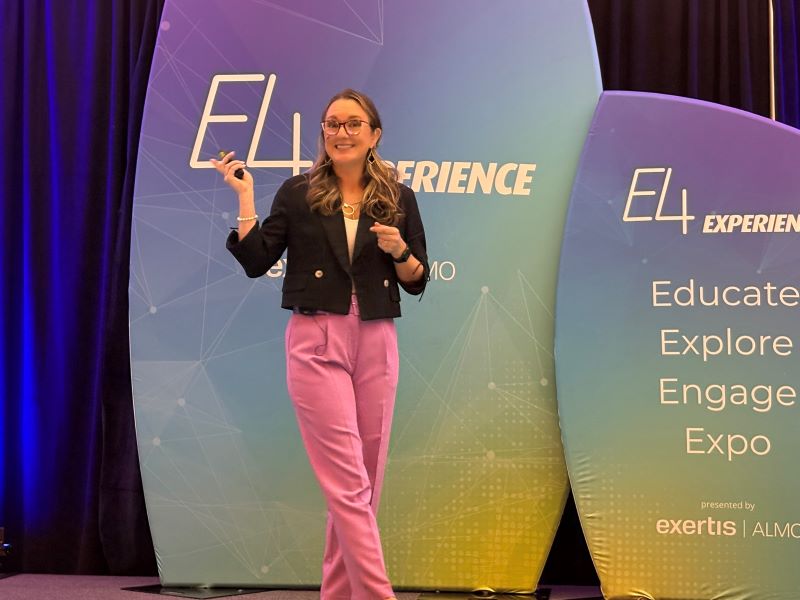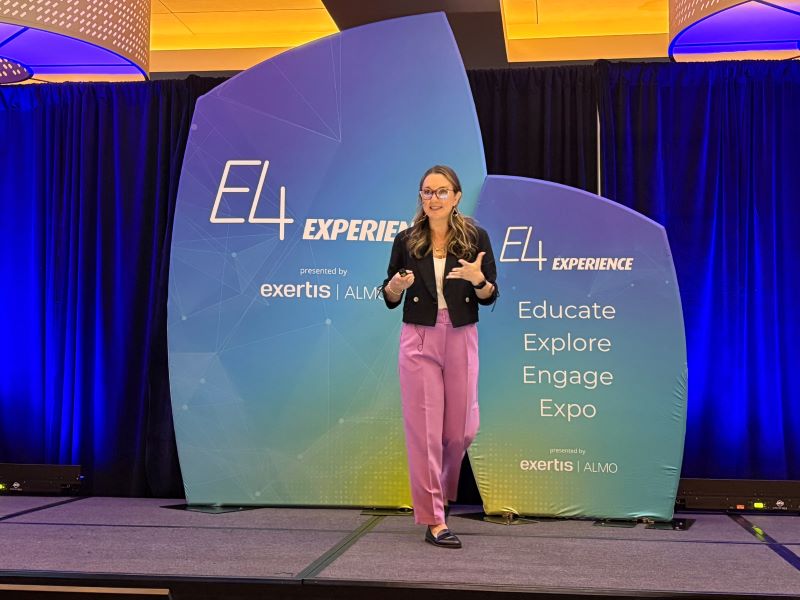Editor’s Note: This story originally was published on March 21, 2025. Since then, it has been updated as of March 24, 2025.
Microsoft is deep into an investment in all things AI, rolling out new features across its entire product category, much of which it calls Copilot, essentially a ChatGPT-powered generative AI tool that is embedded in the Microsoft tools we use most for work.
Where this technology touches the pro AV sector the most is perhaps the meeting room, with Microsoft integrated Copilot into Teams and Teams Room, allowing for a range of intelligent features that are designed to help people on both sides of the Teams call — and even some that can’t make the call — feel like they have an equal seat at the table.
That’s why Amanda Stewart, a Microsoft Teams Rooms Specialist for the company’s North American distribution channels, led a keynote speech at pro AV distributor Exertis Almo’s E4 event in Dallas in early March and led a separate, more detailed session on how integrators can leverage these tools.
The AI Transformation in the Workplace
Stewart emphasized that we are currently in the midst of the fourth major platform shift, driven by AI adoption at an unprecedented pace. While previous shifts like client-server, the internet, and cloud/mobile took years to reach mass adoption, generative AI tools like ChatGPT and Microsoft Copilot have achieved widespread use in mere months.
In a familiar refrain from other AI experts delivering keynotes at tradeshows, Stewart compared the rate of adoption for AI compared to other technologies.
“It took seven years for the Internet to be adopted by 100 million people. … ChatGPT did that in two months,” Stewart said.
In addition, enterprise organizations more than doubled their AI investments between 2023 and 2024, jumping from $19 billion to $44 billion.
“We just don’t see that kind of speed to market and investment in tools like this,” Stewart said.
One of the key takeaways from her presentation was that AI is no longer just a futuristic concept — it is already embedded in workplace tools like Teams, enhancing collaboration and removing mundane, low-value tasks from employees’ workloads.
Watch: How Integration Companies Can Improve Efficiencies Using AI
From Digital Debt to Digital Assistance
Stewart highlighted the challenge of digital debt — the overwhelming influx of emails, notifications and meetings that can stifle productivity. She explained how AI-powered tools like Microsoft Copilot help alleviate this burden by prioritizing emails, summarizing meetings and drafting responses. Instead of sifting through countless messages, employees can rely on AI to identify what requires immediate attention, giving them back hours of valuable time.
“I was so stressed out, overcommitted and overbooked that I had to become an early adopter when it came to AI,” Stewart admitted. “I was desperate to find something that would make me more effective at my job.”
She also emphasized the importance of breaking old habits and adopting AI-driven workflows. Stewart admitted to spending too much time sorting through emails, many of which she never needed to read. Now, Copilot and AI allows users to intelligently search for emails.
“We waste 67 hours a year sorting emails into separate folders,” Stewart said. “You don’t have to do that anymore.”
Enhancing Meetings with AI
Meetings have become a focal point of AI’s impact on the workplace. According to Stewart, the number of meetings has tripled since the pandemic, and the average employee is double-booked 47% more frequently. AI-driven meeting tools aim to tackle this challenge by enabling smarter scheduling, real-time transcription and automated follow-ups.
Microsoft Teams Rooms, enhanced with Copilot, now allow users to “follow” meetings without attending them in real time. This prompts Copilot to summarize discussions, extract key action items and even suggest follow-up tasks based on the conversation. This capability ensures that employees stay informed without needing to be physically present in every meeting.
“I cannot be in two places at once — except now you kind of can,” Stewart quipped.
These features are enabled by other AI technologies built into the Teams software, such as IntelliFrame which frames each individual in a conference room, regardless of room setup. Meeting transcripts have long been a feature in Teams, but capturing what each participant says helps enable those intelligent meeting recaps.
Those technologies are enhanced with enterprise-grade hardware solutions from certified Microsoft Teams Rooms partners to help capture clear and accurate audio and video, which is where integrators fit into this puzzle.
“We have three times as many meetings as we did before the pandemic,” Stewart said. “We might as well make them as effective as possible.”
The Road Ahead for AI in AV and Beyond
As AI continues to evolve, its role in audiovisual technology and workplace solutions is expected to expand. From AI-driven digital signage to intelligent room booking systems, the AV industry is finding new ways to integrate AI for enhanced user experiences. At E4 Dallas, Exertis Almo showcased how AI-powered AV solutions are transforming conference rooms, training centers and hybrid workspaces.
Stewart reinforced that AI is fundamentally changing how people work. “We’re not going back to pre-pandemic workflows,” she stated. “Employees expect flexibility, and AI enables that — by helping people work smarter, not harder.”
The discussion at E4 underscored that AI is not just a passing trend but a fundamental shift in how businesses operate. As more organizations embrace AI-powered collaboration tools, employees will experience greater efficiency, less digital overload, and more meaningful engagement in their work.
Stewart’s keynote and session touched on the fundamental notion that AI is not designed to replace us. Instead, it can help free us up to be more creative and think strategically.
“These low, sort of mundane, tedious tasks that we have all been doing for our entire careers have been replaced with other things that provide greater business value and enjoyment in our day to day because AI is taking over on those things,” Stewart said.
Translating to business value, AI can help us keep up with the pace of work, meaning better productivity and efficiency for the business.
“We can be more innovative when we’re not drowning, leading to better and faster innovation and higher business value,” Stewart noted.


















